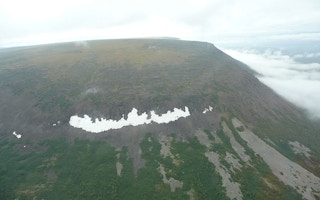Geologists have linked one of the planet’s most devastating events to the burning of fossil fuels, as ancient coal fires set in train a global extinction wave.
Emissions from the fires on a massive scale can be connected to catastrophic events that extinguished most of life on Earth – and this time, humans were not to blame.
It all happened more than 250 million years ago, at the close of the Permian period. And this time the match that lit the flame was massive but slow volcanic eruption in what is now Siberia, a burning that continued for two million years.
In a new study in the US journal Geology, US, Canadian and Russian scientists report that in the course of six expeditions to collect rock samples from a formation known as the Siberian Traps they repeatedly found samples of charred wood and fragments of burnt coal.
Geologists have identified five major extinctions of life in the past, and biologists now argue that – because of human action – a sixth has begun. But the worst of these was the Permian: the oceans acidified to lethal levels as carbon dioxide ratios in the atmosphere soared, and tropical ocean temperature reached fever pitch at 40°C.
“
Our study shows that the Siberian Traps magmas combusted large quantities of coal and organic matter during eruption.
Linda Elkins-Tanton, lead researcher, Arizona State University
Altogether, 96 per cent of marine species disappeared, and 70 per cent of land creatures. The event closed the Permian era, and ushered in the Triassic, and the beginning of the dinosaurs.
For geologists, the past is the key to the present: what happened once can happen again. And it now seems that the fuel that generated the high temperatures and acidic oceans was coal, laid down in the 50 million years of the Carboniferous that ended with the arrival of the Permian.
The Permian catastrophe has puzzled palaeontologists for decades, and the latest finding is not likely to be the end of the argument. Catastrophic climate change has been linked to most of the ancient extinctions. High carbon levels in the late Permian atmosphere have been implicated from the start.
Spur to action
Highly acidic seas – the oceans are the oldest, largest and richest of life’s habitats – have been named as prime suspect. Damage to the ancient ozone layer has also been cited. But in all cases, the cause of the sudden surge in atmospheric carbon has been up for debate: humans are implicated in climate change now. But what caused it then?
The answer: slowly slurping fiery magma (molten rock) from ancient volcanic sources, enough to cover 7 million square kilometres; enough to amount to 4 million cubic kilometres of once-smoking basalt that spilled over vast areas of old forest, buried peat and deeper fields of coal.
“Our study shows that the Siberian Traps magmas intruded into and incorporated coal and organic material. That gives us direct evidence that the magmas also combusted large quantities of coal and organic matter during eruption,” said Linda Elkins-Tanton, of Arizona State University, who led the research.
“Seeing these similarities gives us extra impetus to take action now, and also to further understand how the Earth responds to changes like these in the longer term.”
This story was published with permission from Climate News Network.

















